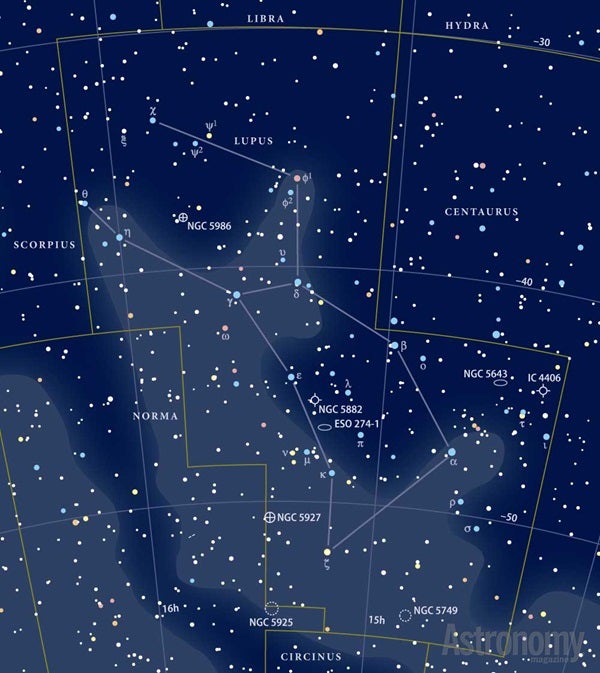Targets for June 30–July 7, 2016
Small telescope: Three double stars in Boötes
Small telescope: Globular cluster NGC 5986
Large telescope: Elliptical galaxy NGC 5846
This week’s first small-telescope target is a trio of double stars in the constellation Boötes the Herdsman. I’ll start with Xi (ξ) Boötis.
You’ll have no trouble locating this nicely colored binary. It sits 8.5° due east of Arcturus (Alpha [α] Boötis). The primary shines at magnitude 4.7 and the secondary at magnitude 7.0.
The separation right now — 6.9″ — is reasonably close, so crank the power above 100. The brighter component shines white, although many observers see it as yellow. Almost everyone sees the other star as orange, however.
The second double star is 44 Boötis. You’ll find it in the far northern part of the constellation, 7.3° due north of Nekkar (Beta [β] Boötis).
The brighter of the two shines at magnitude 5.3 and its companion is at magnitude 6.2. With a separation of only 1.6″, these two stars will test the limits of 3-inch telescopes. In fact, because of the closeness of the main stars, you’ll need to crank the magnification above 150x just to split the pair.
The primary and secondary are yellow-white and yellow-orange, respectively. The secondary is also a type of binary star astronomers call a contact binary. As the name implies, its two suns are so close that gravity distorts their atmospheres, which touch. You won’t be splitting that pair of the system.
The third of my double-star choices this week is the easiest to find and to split. It’s Delta (δ) Boötis. The primary star shines at magnitude 3.5 and the secondary glows at magnitude 8.7. Although these magnitudes represent a brightness difference of 120 the 105″ separation between the pair makes seeing the fainter star easier.
Although you can separate this wide binary through binoculars or a finder scope, you’ll want to use a telescope at a magnification around 50x to bring out the stars’ colors.
The primary is yellow, while the secondary shines white, or perhaps yellow-white.
A cluster to howl about
This week’s deep-sky small-scope object is globular cluster NGC 5986 in Lupus the Wolf. It shines relatively brightly at magnitude 7.6 and measures 9.8′ across.
You’ll find it 2.8° west of magnitude 3.6 Eta (η) Lupi. From a dark site through a 4-inch telescope at a magnification of 200x, this cluster appears irregular and mottled. The cluster remains unresolved near its center except for one star 1′ northeast of the core. That’s magnitude 11.2 GSC 7837:1334.
Step up to an 11-inch scope, however, and several dozen stars will resolve into points. NGC 5986 lies about 35,000 light-years from Earth and roughly 15,000 light-years from the Milky Way’s center.
Slightly out of round
This week’s large-telescope target is elliptical galaxy NGC 5846 in Virgo. You’ll have to head to the easternmost edge of the constellation for this object. It lies 1° east-southeast of the magnitude 4.4 star 110 Virginis. The galaxy glows at magnitude 10.0 and measures 4′ by 3.7′.
Through a 10-inch telescope, this star system appears round with a broad bright central region and a wide halo. Crank up the power past 300, and look for the magnitude 13.8 galaxy NGC 5846A buried in the southeast part of the main object’s halo.
NGC 5846 is the brightest in a slightly curved line of four galaxies oriented east to west. The easternmost, magnitude 12.7 NGC 5839, lies 15′ east of NGC 5846. Between those two sits magnitude 12.5 NGC 5845. Finally, the nice magnitude 10.8 spiral NGC 5850 lies 10′ east-southeast of NGC 5846.
Expand your observing at Astronomy.com
The Sky this Week
Get a daily digest of celestial events coming soon to a sky near you.
Observing Basics
Find more guidance from Senior Editor Michael E. Bakich with his Observing Basics video series.










